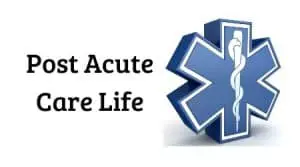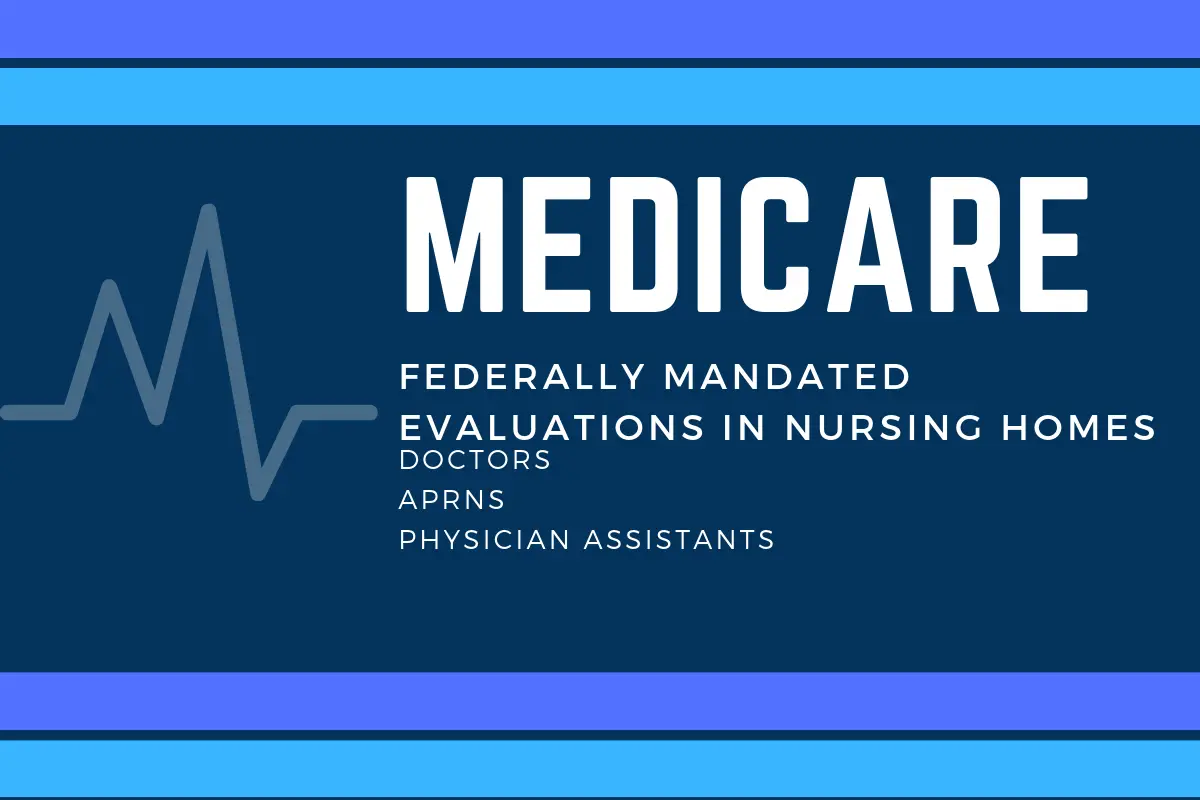In the nursing home setting, there are federally mandated visits that must be completed by medical doctors. There are also opportunities to delegate these responsibilities to physician assistants and advanced nurse practitioners.
When performing these evaluations, it is essential to note when the doctor must complete the progress note, and when it is OK for another provider.
Per Medicare guidelines, the first admission note must be made by the doctor as well as the second and third months. “A required physician visit includes the initial comprehensive visit in a SNF and every alternate required visit thereafter, as required in 42 C.F.R. §483.40(c)(4).”
After the initial three-month period, the doctor can delegate the responsibility to another provider such as an APRN or PA. However, the doctor will still need to alternate visits every other month with the other provider.
Evaluating patients for the mandated E&M visit requires you to perform a thorough physical exam, history and physical. You will need to determine how the patient is doing.
Document any change in the plan of care or other pertinent health information regarding the patient state of being.
Reporting Federally Mandated Visits
“The 5-day assessment” per Medicare, is the first recorded assessment by the doctor and must be completed within this timeframe. However, some records actually allow for an eight-day window.
Specific state rules may require the doctor to evaluate and document on resident sooner than medicare guidelines. However, discussing state regulations is beyond the scope of this post.
When it comes to Medicare federally mandated visits, they will reimburse for visits completed
- Upon admission, then then the following two months
- The doctor will then need to evaluate at once every 60 days
- The fourth month can be delegated to another provider, then every 60 days
Medicare requires that medical evaluations must occur within ten days of the due date. Either ten days before or ten days after the due date of the 30/60 day evaluation.
Which CPT codes do you use for mandated visits
The physician will utilize CPT codes 99304-99306 to report the admission evaluation. The other provider (APRN’s and PA’s) will use CPT codes 99307-99310 for these exams, depending on the medical complexity of the exam.
If another provider is seeing the patient before the doctor completes their initial evaluation, they will use CPT code 99307-99310 to report the E&M visit. The same CPT codes (99307-99310) are used for alternating visits with the doctor.
Components of the visit note
Medicare developed these regulations to encourage the doctor to take an active role in supervising the care of residents.
Medicare doesn’t want these regulatory E&M visits to be superficial exams. These visits should develop a plan of care for the resident while evaluating the resident’s current condition.
The physician must evaluate a new admission to the nursing home in a timely fashion and document the results of that assessment, along with a treatment plan in the patient’s chart.
The progress note should include:
1. History and Physical
2. Review of systems
3. An assessment of Current condition or issues
4. The treatment plan of care
5. Goals of care
6. Rehabilitation potential
7. Diagnoses
Additional items to include with the documentation
Cognitive patterns:
Does the patient need to follow up with the psych APRN? Any medical issues that may be causing a cognitive delay?
Review common causes of cognitive issues and see if there are any potential changes that can be made in the medication and treatment plan to lessen these issues.
Communication/hearing problems:
Any aphasia? Maybe hearing difficulties contributing to cognitive problems? Other concerns?
Make sure to utilize a translator when there are language barriers. If there isn’t an employee available to translate, there are services that can translate for the evaluation. You will have to speak with the facility to see who they use.
Patients with hearing difficulties should be assessed with an otoscope to see if there is cerumen impaction. You can then order debrox with follow-up removal of the impacted cerumen.
Disease/diagnoses:
Spend time documenting issues or concerns that may affect the health and wellness of the patient? Update any diagnosis codes that may be out of date. Also, add any diagnoses that may be missing from their medical records.
With updates in payment models for nursing homes, it will be important to capture the primary diagnosis for the patient being admitted to the facility. There are also other diagnoses such as HIV that add to the level of complexity for the patient.
If you are able, document how the diseases can affect future care and healing of the resident.
Health conditions:
What can you do to improve the health of the patient? Any workup needed? Is the patient declining in health?
Similar to a review of the diagnoses, but this involves identifying issues that may have not been diagnosed yet. Is the patient presenting with symptoms not yet worked up? This is the time to order any labs or studies that will help in pinpointing the cause.
You should also document the use of tobacco products, alcohol, and/or illicit drugs. Come up with an intervention and treatment plan. Medicare currently allows you to bill for tobacco and ETOH cessation and counseling. This would be an “addon code” to the visit.
Medications:
This is a great opportunity to de-prescribe unneeded medications. Also, look for any medications that may require the levels to be checked such as Dilantin, Carbamazepine, valproate acid, and warfarin).
Make sure to sign the facility order sheets that include the current medications. This is usually done after the visit is complete with the signature and date of the visit.
Physical functioning and structural problems:
Perform an exam that addresses any of the complaints noted by the patient as well as the diagnosis you will list in the assessment and plan section.
Identify opportunities for the patient to get physical therapy as well as missed issues and concerns. Do they have pain to joints that they didn’t report to the staff? Any unexplained bruising or open areas?
Documentation should consist of the following
When documenting a federally mandated visit, there should always be a chief complaint discussing the reason for the visit. Since it’s for a mandated visit, there may not be any health issues.
The chief complaint should clearly state that the visit is for the “federally mandated 30-60 day evaluation of patient”.
There should be a review of the plan of care for the patient, including any medication, new diagnoses, and the current status of these diagnoses.
All progress notes need to have the name of the provider completing the visit, the signature of the practitioner, and the date of the evaluation.
Document the time spent on the visit when appropriate to help support the level of care billed.
When appropriate, chart on the diet of the resident along with any safety issues including plans for future discharge to home.
Medicare documentation must provide a complete picture of the skilled nursing and therapy needs of the patient.
The facilities need the documentation to help justify the clinical reasons and medical necessity to have them at the nursing home. These notes help explain the necessity of the skilled services being delivered along with the need for coverage.
Sick Visit
If you identify health issues during the exam you can include them in your federally mandated visit. You would also want to follow up on any medical issues identified during your evaluation.
If you are seeing the patient for a sick visit and the federally mandated visit is due, you should combine each into one visit. Many people separate visits to different dates which is not the correct thing to do.
Annual Exams vs. Mandated visits
Annual assessments utilizing the CPT code 99318 is a federally mandated evaluation that is done one year and one day after the previous year’s exam.
This yearly exam can substitute the sixty-day assessment and should not be completed in addition to the required federally mandated visits.
Where should regulatory visits be performed?
These nursing home regulatory exams are expected to occur at the nursing home rather than in the doctor’s office. However, if specialty office equipment is required or the resident requests then it can be completed during an office visit.
These evaluations require that the medical provider perform these visits in person and not via telehealth or by telephone. The note should be in the patient’s medical record within 24 hours of seeing the resident.
(Per AMDA guidelines) Progress notes should provide an evaluation of the resident’s condition, current status, and goals. When possible, include the progress of the patient and any recent illnesses or hospitalizations since the last visit.
Review pertinent diagnostic studies and laboratory testing with a discussion of results with each visit. Document follow-up testing, along with subsequent interventions when needed.
Regulatory visits are also an ideal time to document the end of life decisions include the code status of the patient. Medicare now allows providers to bill for advance directive discussions even if changes are not made to code status.
Resolving Diagnoses
When evaluating the patient, take the time to “resolve any diagnoses” still listed on medical records. Some facilities review the diagnosis list every quarter, while others never reconsider them. By reviewing with each mandated visit, it will lessen the burden.
When removing and stating a diagnosis has resolved, make sure to provide supporting documentation of resolution. No documentation needed with self-resolving diagnoses such as otitis media and respiratory infections.
Telephone Orders
All telephone orders require signatures from a physician or to be cosigned by other medical providers. States have different requirements for signature timelines. Telephone orders should be signed by the physician within the required time frame as defined by state law. There are no federal regulations that specify a specific time for countersignature by the physician or other medical providers.
It is recommended that you sign telephone orders at the time of the regulatory visit and when you are seeing patients for E&M visits.
Medicare Certification/Recertification
If you work in a nursing home as a medical practitioner, you will be approached to sign the medicare certification/recertification paperwork. These forms can be signed by all providers such as Doctors, Nurse Practitioners and or Physician Assistants.
These certifications are required upon admission to the nursing home. The next recertification is before day 14, and then every 30 days after that. These signatures will continue during their Medicare part A coverage.
You do not have to wait for the regulatory visit to sign these visits. They should be done in a timely fashion without delay of a visit.
Conclusion
These federal regulations hold doctors responsible for the program of care for the resident. Even when visits get delegated to other providers, the physician needs to continue to monitor the progress of the patient.
Always think of state law which usually defines the nurse practitioners and physician assistant authority and should be reviewed to determine if counter signatures are required.
Use your time doing the regulatory visits to get to know your patients and provide the best care possible.
In the end, always stay within the Scope of Practice-State Board of Nursing, employer or other credentialing/privileging bodies.
References
CMS (2014) Revised: 01.18.19. Reporting Federally Mandated Visits (CPT
Codes 99307-99310).
https://www.cgsmedicare.com/partb/pubs/news/2014/0114/cope24339.html
Retrieved 9/21/2019
CMS Medicare Claims Processing Manual (Pub. 100-04), chapter 12, section
30.6.13. https://www.cms.gov/Regulations-and-Guidance/Guidance/Manuals/Downloads/clm104c12.pdf
Retrieved September 21, 2019

